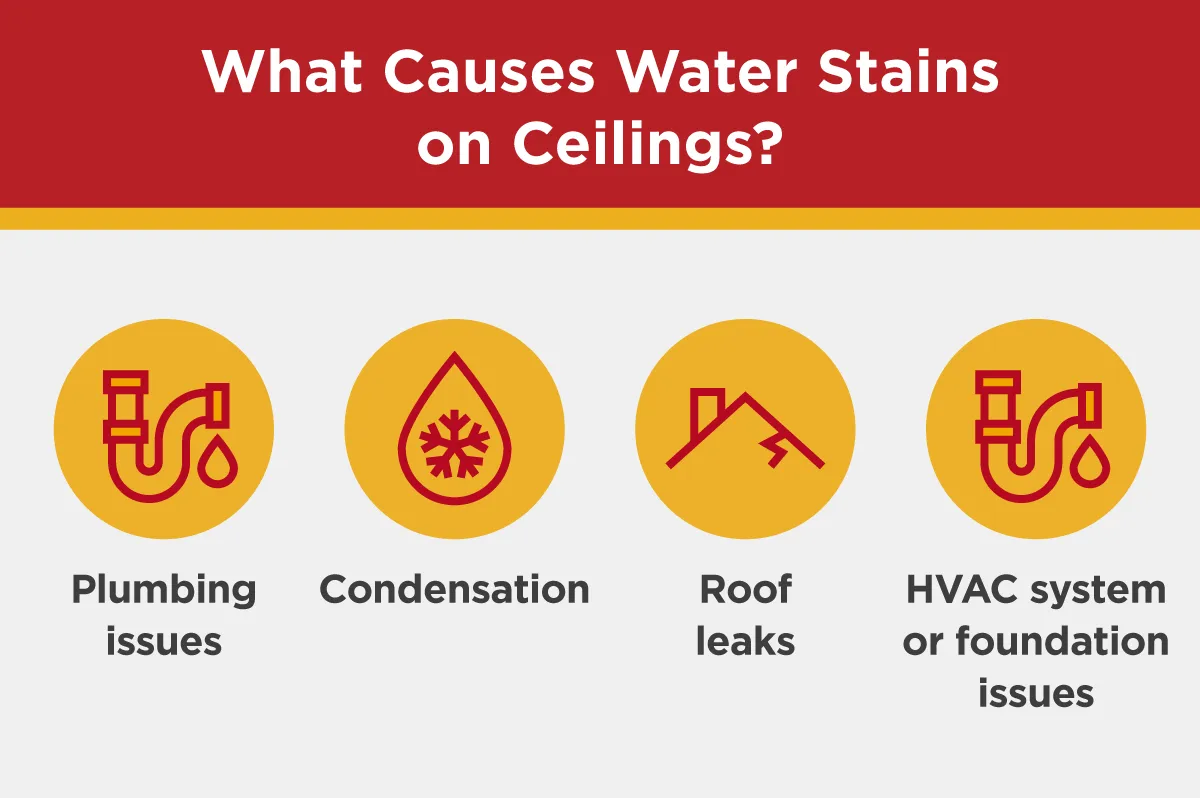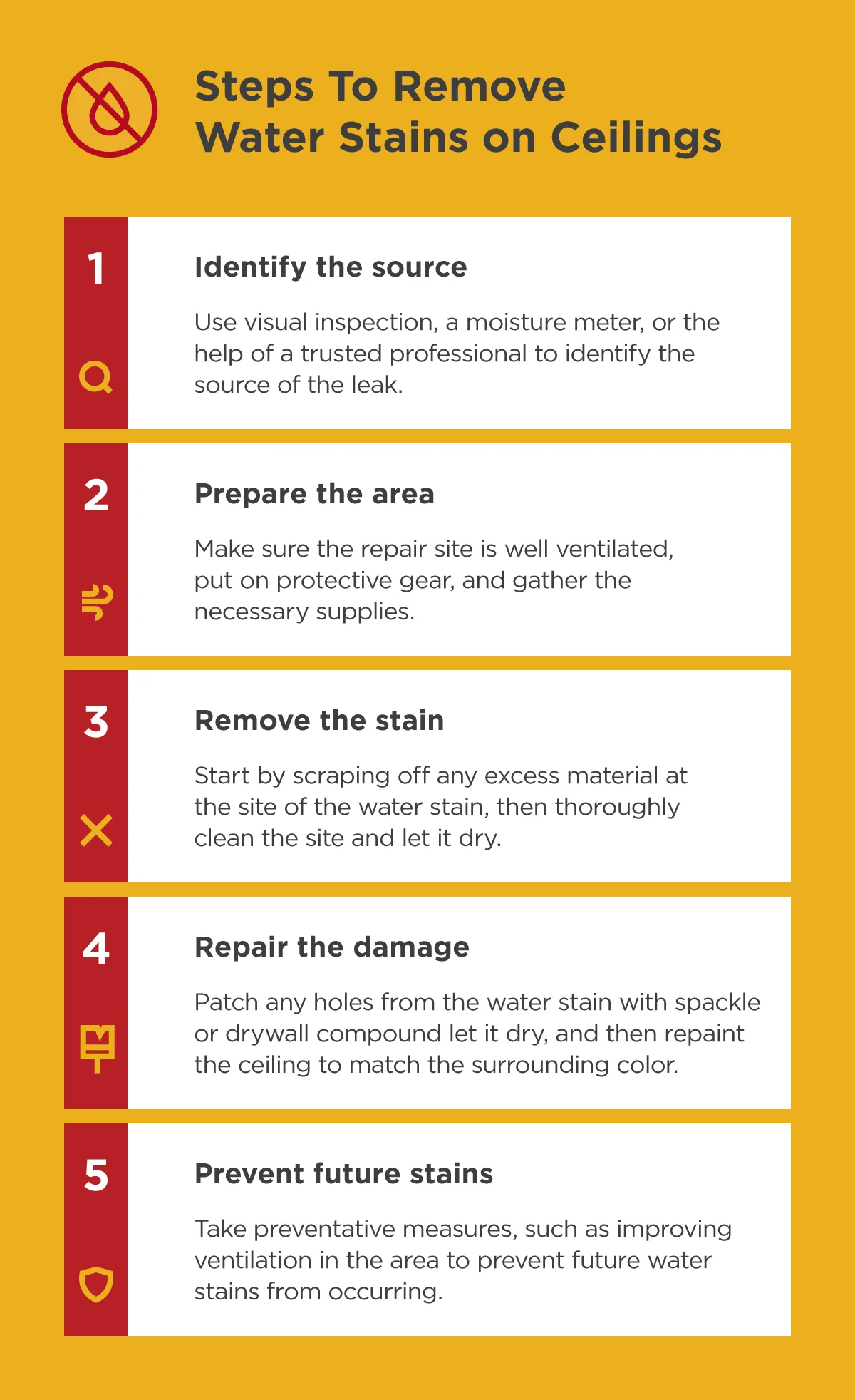Water Stains on Ceilings: Causes, Removal, and Prevention
You’re in your kitchen one morning, preparing your coffee, when out of the corner of your eye, you see an unfamiliar splotch of brown on the ceiling. You turn to investigate further and there it is: the beginning of a water stain on your kitchen ceiling.
Unfortunately, a water stain on the ceiling is a common issue many homeowners have to deal with. But what causes water stains on ceiling areas? And how can you remove them and, better yet, prevent them from happening in the first place?
Causes of Water Stains on Ceilings
So, what causes water stains on ceilings? From roof damage to internal plumbing leaks, there are a number of potential contributors to the formation of water stains. Learn more about the causes of those unsightly water spots on ceilings below.

Roof leaks
Exterior roof leaks are one of the most common culprits of water stains. These roof leaks can range from minor annoyances to massive repairs.
Roof flashing issues often lead to water leaks. If the roof flashing on your home is old, worn away, missing, or in any way faulty, it could lead to leaks inside the home. In addition, if your pipe boot (a type of roof flashing that protects the base of pipes within your roof) fails, you may end up with a roof leak that leads to a brown water stain on ceiling interiors.
Shingle damage (and shingle wear and tear) can also lead to roof leaks and water stains on the ceiling in your kitchen, living room, and other areas. Small holes in the roof from old or improperly set nails may also cause tiny leaks through the roof of your home that can lead to water damage.
Plumbing issues
Plumbing issues are another common cause of water stains on ceilings. Especially in older homes or recently built or renovated homes, you’ll want to inspect pipes as a possible contributor to any water stains you’re observing.
Bathrooms are usually a good place to look if you suspect plumbing issues are at the root of your water stains. Toilet seals, rings, gaskets, and caulking degrade over time and can lead to leaks. Clogging or overflow related to toilets and their plumbing is also a major cause of water stains.
Condensation
If your home has high levels of humidity and suboptimal ventilation, condensation issues may be to blame for a water stain or a wet spot on the ceiling. Problematic condensation can occur in areas such as the bathroom, kitchen, and laundry room—areas where steam is prevalent but ventilation is poor. This leads to a buildup of moisture that can then cause water stains.
Additional causes of water spots on ceilings
Other possible causes of water spots on ceilings include issues with HVAC systems (such as a leaky duct, a cracked drip pan, or clogged drain lines), issues with the foundation of a home (cracks and leaks, especially near the chimney), and improperly installed skylights.
How To Identify the Source of Water Stains
Before you take any action to address a water stain, you first need to identify the source. Here are some key steps you can take on your own to initially identify the potential source of water stains on your ceiling.
- Visually inspect the ceilings: The easiest place to start with visual inspection is the ceiling itself. If the water stain exists in a bathroom, kitchen, or high-steam area, this may indicate that condensation is the cause of the stain.
- Visually inspect the roof: Can you observe areas of your roof where shingles are missing? Or perhaps where there's buildup of mold on the roof itself? These are both likely “hot spots” for a leak that’s creating water damage. It’s also helpful to check the attic, if your home has one, since roof leaks and other common home issues are often easily detected there.
- Visually inspect the plumbing: Inspect the caulking in the bathroom, especially around the toilet and sink. Is any of the caulking old and in need of replacement? Also, check the drainage of your toilet and bathroom sink. Take a peek under the sink to ensure there are no visible leaks from your plumbing.
- Use a moisture meter: Moisture meters are tools designed to measure the percentage of water in a given material, including wood, concrete, even soil. You can use a moisture meter to take readings around your home and see where the highest values occur—this may indicate the origin of the leak.
- Call a professional: In most cases, it's best to call a leak detection professional to assess where the water stain is originating. Especially if you suspect plumbing may be the source of your water stain, you may not have the tools, knowledge, or physical ability to assess and conduct repairs on your own. Water leaks are not to be taken lightly, and it's best to address water stains as soon as possible.
How To Remove a Water Stain on the Ceiling
The process of repairing a ceiling water stain has a few crucial components. Read on to learn how to cover water stains on ceilings, and when to call a professional for repair.

1. Identify the source
Before taking action to remove a water stain on your ceiling, you must first identify where the water is coming from. Visually inspect the ceiling, roof, pipes, and plumbing fixtures to determine where water is getting through. If there are areas of your home you cannot personally assess (roof, internal plumbing, foundation of the home, etc.), call a trained professional.
2. Prepare the area
Once you’ve identified the source and have taken the necessary steps to fix the leak, it’s time to prepare the area for repair. If you are conducting the repair yourself, you’ll want to first make sure that the area is well-ventilated; open nearby doors and windows if you’re inside the house. In addition, wear protective gear such as work gloves, goggles, and paint-friendly clothing.
Next, gather the supplies you’ll need to complete the water stain repair. Recommended materials include a ladder, putty knife, damp cloth, mild detergent, and paintbrush.
3. Remove the stain
Now it’s time to remove the water stain and water-compromised materials from the ceiling. Start by using a putty knife to gently scrape off any excess material at the site of the water stain, such as peeling paint or plaster. You’ll want this surface to be as smooth as possible before applying any spackle or paint.
Once all excess material has been removed, thoroughly clean the stained area with a damp cloth and mild detergent to remove dirt and grime. Allow the area to dry completely before proceeding.
4. Repair the damage (if necessary)
After the water stain site has completely dried, you can move forward with visual repair. If there are any holes in the ceiling, start by patching them with spackle or drywall compound. Once the area is dry and painting conditions are ideal, repaint the ceiling to match the surrounding color. If you’re not sure how to fix water stains on the ceiling, contact a professional for help.
How To Prevent Water Stains
As the saying goes, “an ounce of prevention is worth a pound of cure.” The best way to repair a water stain on a ceiling is to not have to deal with one in the first place. Here are some ways you can stay on top of conditions that might lead to water stains and keep your ceilings as stain-free as possible.

- Regular maintenance: As with many elements of home safety, regular maintenance is key. Get a professional roof inspection every two years if your house is more than 10 years old, and stay on top of your home’s plumbing and HVAC system health.
- Address underlying issues: Especially in older homes, infrastructure and foundational elements can start to play a bigger role in the condition of your home, and may ultimately lead to leaks that cause water damage. If you suspect an issue with your home’s insulation, foundation, or building materials, contact a professional for an inspection.
- Conduct professional inspections: The ideal time to get a thorough inspection done on your home is during the homebuying process so you're aware of any potential issues as soon as possible. After moving in, it’s recommended that you get a home maintenance inspection completed every three to five years.
Call Mr. Handyman® for Ceiling Repair Services
Whether you're looking for help detecting the source of a leak that’s causing a water stain on the ceiling in your home or executing a ceiling repair or major remodel after water damage, Mr. Handyman can help.
Our experienced service professionals can assist you with addressing existing water damage and provide helpful solutions to prevent future water damage from occurring. Request a service from our team of experts today.
This article is intended for general informational purposes only and may not be applicable to every situation. You are responsible for determining the proper course of action for your home and property. Mr. Handyman is not responsible for any damages that occur as a result of this blog content or your actions. For the most accurate guidance, contact your local Mr. Handyman location for a comprehensive, on-site assessment.
Water Stains on Ceilings FAQs
Mr. Handyman has been helping homeowners repair, maintain, and enhance their spaces for over 25 years! We are the one-stop solution for everything on your to-do list. This includes answering your questions about home repairs, maintenance, and improvements. Here are answers to some of your most frequently asked questions about water stains on ceilings.
Is a water stain on a ceiling serious?
Yes, water stains on a ceiling are a serious issue since water stains often indicate a longstanding leak. A wet ceiling can break, fall, and hurt someone. Not to mention, damp drywall is the ideal environment for mold growth. If you have a water stain on your ceiling, it’s best to get it repaired immediately.
Why is there a water mark on my ceiling but no leak?
If you notice a water mark on your ceiling but can’t detect a leak, condensation may be to blame, especially if the water mark is in an area that frequently experiences high levels of steam, such as the kitchen, bathroom, or laundry room.
What causes brown water stains on the ceiling?
Brown water stains on the ceiling of your home can be caused by a number of factors, including water leaks from the roof, internal plumbing leaks, HVAC system issues, improperly installed skylights, or a buildup of condensation.
How to fix straight line water stains on the ceiling?
To fix a straight line water stain on a ceiling, you’ll first need to identify the source of the stain. If the source is a leak, make the necessary repairs to prevent future water from draining onto the stain line. Then, you can either remove or replace the affected area or thoroughly scrape, clean, and dry the stain before painting over it.
 Click to call
Click to call


